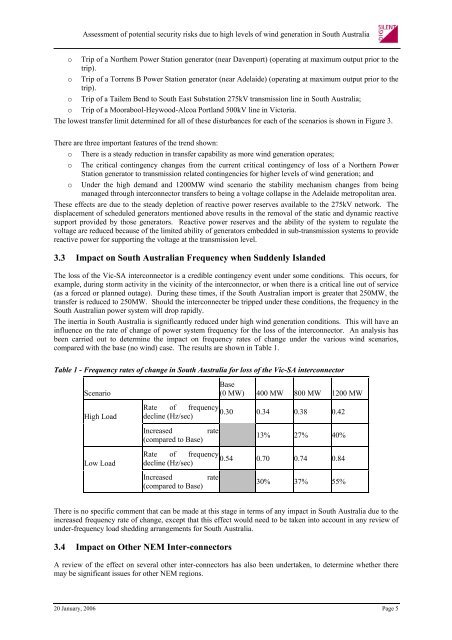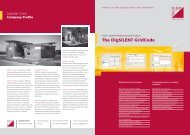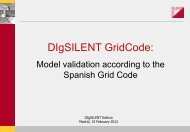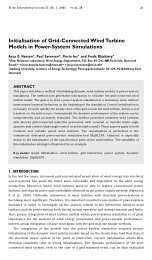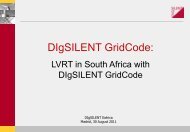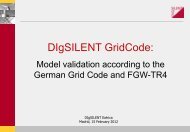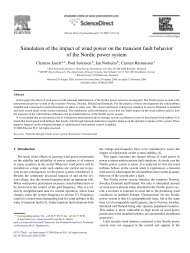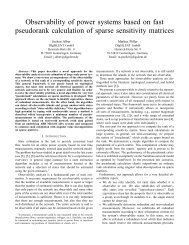Assessment of Potential Security Risks due to High ... - DIgSILENT
Assessment of Potential Security Risks due to High ... - DIgSILENT
Assessment of Potential Security Risks due to High ... - DIgSILENT
You also want an ePaper? Increase the reach of your titles
YUMPU automatically turns print PDFs into web optimized ePapers that Google loves.
<strong>Assessment</strong> <strong>of</strong> potential security risks <strong>due</strong> <strong>to</strong> high levels <strong>of</strong> wind generation in South Australia<br />
o Trip <strong>of</strong> a Northern Power Station genera<strong>to</strong>r (near Davenport) (operating at maximum output prior <strong>to</strong> the<br />
trip).<br />
o Trip <strong>of</strong> a Torrens B Power Station genera<strong>to</strong>r (near Adelaide) (operating at maximum output prior <strong>to</strong> the<br />
trip).<br />
o Trip <strong>of</strong> a Tailem Bend <strong>to</strong> South East Substation 275kV transmission line in South Australia;<br />
o Trip <strong>of</strong> a Moorabool-Heywood-Alcoa Portland 500kV line in Vic<strong>to</strong>ria.<br />
The lowest transfer limit determined for all <strong>of</strong> these disturbances for each <strong>of</strong> the scenarios is shown in Figure 3.<br />
There are three important features <strong>of</strong> the trend shown:<br />
o There is a steady reduction in transfer capability as more wind generation operates;<br />
o The critical contingency changes from the current critical contingency <strong>of</strong> loss <strong>of</strong> a Northern Power<br />
Station genera<strong>to</strong>r <strong>to</strong> transmission related contingencies for higher levels <strong>of</strong> wind generation; and<br />
o Under the high demand and 1200MW wind scenario the stability mechanism changes from being<br />
managed through interconnec<strong>to</strong>r transfers <strong>to</strong> being a voltage collapse in the Adelaide metropolitan area.<br />
These effects are <strong>due</strong> <strong>to</strong> the steady depletion <strong>of</strong> reactive power reserves available <strong>to</strong> the 275kV network. The<br />
displacement <strong>of</strong> scheduled genera<strong>to</strong>rs mentioned above results in the removal <strong>of</strong> the static and dynamic reactive<br />
support provided by those genera<strong>to</strong>rs. Reactive power reserves and the ability <strong>of</strong> the system <strong>to</strong> regulate the<br />
voltage are reduced because <strong>of</strong> the limited ability <strong>of</strong> genera<strong>to</strong>rs embedded in sub-transmission systems <strong>to</strong> provide<br />
reactive power for supporting the voltage at the transmission level.<br />
3.3 Impact on South Australian Frequency when Suddenly Islanded<br />
The loss <strong>of</strong> the Vic-SA interconnec<strong>to</strong>r is a credible contingency event under some conditions. This occurs, for<br />
example, during s<strong>to</strong>rm activity in the vicinity <strong>of</strong> the interconnec<strong>to</strong>r, or when there is a critical line out <strong>of</strong> service<br />
(as a forced or planned outage). During these times, if the South Australian import is greater that 250MW, the<br />
transfer is reduced <strong>to</strong> 250MW. Should the interconnecter be tripped under these conditions, the frequency in the<br />
South Australian power system will drop rapidly.<br />
The inertia in South Australia is significantly reduced under high wind generation conditions. This will have an<br />
influence on the rate <strong>of</strong> change <strong>of</strong> power system frequency for the loss <strong>of</strong> the interconnec<strong>to</strong>r. An analysis has<br />
been carried out <strong>to</strong> determine the impact on frequency rates <strong>of</strong> change under the various wind scenarios,<br />
compared with the base (no wind) case. The results are shown in Table 1.<br />
Table 1 - Frequency rates <strong>of</strong> change in South Australia for loss <strong>of</strong> the Vic-SA interconnec<strong>to</strong>r<br />
Scenario<br />
<strong>High</strong> Load<br />
Low Load<br />
Base<br />
(0 MW) 400 MW 800 MW 1200 MW<br />
Rate <strong>of</strong> frequency<br />
0.30 0.34 0.38 0.42<br />
decline (Hz/sec)<br />
Increased rate<br />
(compared <strong>to</strong> Base)<br />
13% 27% 40%<br />
Rate <strong>of</strong> frequency<br />
0.54 0.70 0.74 0.84<br />
decline (Hz/sec)<br />
Increased rate<br />
(compared <strong>to</strong> Base)<br />
30% 37% 55%<br />
There is no specific comment that can be made at this stage in terms <strong>of</strong> any impact in South Australia <strong>due</strong> <strong>to</strong> the<br />
increased frequency rate <strong>of</strong> change, except that this effect would need <strong>to</strong> be taken in<strong>to</strong> account in any review <strong>of</strong><br />
under-frequency load shedding arrangements for South Australia.<br />
3.4 Impact on Other NEM Inter-connec<strong>to</strong>rs<br />
A review <strong>of</strong> the effect on several other inter-connec<strong>to</strong>rs has also been undertaken, <strong>to</strong> determine whether there<br />
may be significant issues for other NEM regions.<br />
20 January, 2006 Page 5


